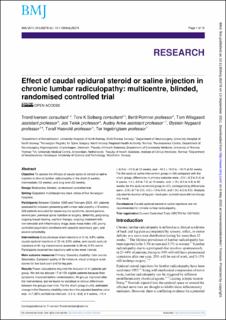| dc.description.abstract | Abstract
Objective To assess the efficacy of caudal epidural steroid or saline injection in chronic lumbar radiculopathy in the short (6 weeks), intermediate (12 weeks), and long term (52 weeks).
Design Multicentre, blinded, randomised controlled trial.
Setting Outpatient multidisciplinary back clinics of five Norwegian hospitals.
Participants Between October 2005 and February 2009, 461 patients assessed for inclusion (presenting with lumbar radiculopathy >12 weeks). 328 patients excluded for cauda equina syndrome, severe paresis, severe pain, previous spinal injection or surgery, deformity, pregnancy, ongoing breast feeding, warfarin therapy, ongoing treatment with non-steroidal anti-inflammatory drugs, body mass index >30, poorly controlled psychiatric conditions with possible secondary gain, and severe comorbidity.
Interventions Subcutaneous sham injections of 2 mL 0.9% saline, caudal epidural injections of 30 mL 0.9% saline, and caudal epidural injections of 40 mg triamcinolone acetonide in 29 mL 0.9% saline. Participants received two injections with a two week interval.
Main outcome measures Primary: Oswestry disability index scores. Secondary: European quality of life measure, visual analogue scale scores for low back pain and for leg pain.
Results Power calculations required the inclusion of 41 patients per group. We did not allocate 17 of 133 eligible patients because their symptoms improved before randomisation. All groups improved after the interventions, but we found no statistical or clinical differences between the groups over time. For the sham group (n=40), estimated change in the Oswestry disability index from the adjusted baseline value was −4.7 (95% confidence intervals −0.6 to −8.8) at 6 weeks, −11.4 (−6.3 to −14.5) at 12 weeks, and −14.3 (−10.0 to −18.7) at 52 weeks. For the epidural saline intervention group (n=39) compared with the sham group, differences in primary outcome were −0.5 (−6.3 to 5.4) at 6 weeks, 1.4 (−4.5 to 7.2) at 12 weeks, and −1.9 (−8.0 to 4.3) at 52 weeks; for the epidural steroid group (n=37), corresponding differences were −2.9 (−8.7 to 3.0), 4.0 (−1.9 to 9.9), and 1.9 (−4.2 to 8.0). Analysis adjusted for duration of leg pain, back pain, and sick leave did not change this trend.
Conclusions Caudal epidural steroid or saline injections are not recommended for chronic lumbar radiculopathy. | |

